Seattle Pacific University
.png) | |
Former names | Seattle Seminary |
|---|---|
| Motto | Engaging the Culture, Changing the World |
| Type | Private |
| Established | 1891 |
| Affiliation | Free Methodist Church |
| Endowment | $100 million[1] |
| President | Daniel J. Martin |
| Undergraduates | 3,467 (2015) |
| Postgraduates | 975 (2013) |
| Location |
Seattle, Washington, US 47°39′01″N 122°21′42″W / 47.65019°N 122.361667°WCoordinates: 47°39′01″N 122°21′42″W / 47.65019°N 122.361667°W |
| Campus | Urban, 43 acres (170,000 m2) |
| Colors | Maroon and White |
| Athletics | NCAA Division II – GNAC |
| Nickname | Falcons |
| Affiliations | |
| Sports | 12 varsity teams |
| Mascot | Talon the Falcon |
| Website | spu.edu |
Seattle Pacific University (SPU) is a private liberal arts university in Seattle, Washington, founded in 1891 in conjunction with the Oregon and Washington Conference of the Free Methodist Church as the Seattle Seminary. It became the Seattle Seminary and College in 1913, adopting the name Seattle Pacific College in 1915, and took its present moniker in 1977. Seattle Pacific University is a member of the Christian College Consortium.
Seattle Pacific is tied for 151st in the 2018 U.S. News and World Report's Best National Universities rankings; it is the only private university in the Pacific Northwest to make that list, and the only Christian College Consortium member to be ranked a Best National University.[3] SPU joins the University of Washington and Washington State University as the only three institutions from Washington state named to the magazine’s list.[4]
History
Founded in 1891 by Free Methodist pioneers, Seattle Pacific University has grown from humble beginnings on a small piece of land in early Seattle, Washington, into one of the nation’s Christian universities, located in the heart of one of the world’s cities.
The early vision of the institution was to train missionaries for overseas service. Today that vision has grown to focus on equipping 4,000 undergraduate and graduate students to engage the culture and change the world.[5]
On June 5, 2014, a shooting occurred in Otto Miller Hall in which one student was killed and two other students were injured. The suspect was not a student at the school and had no connection to the university.[6] The gunman was stopped by student Jon Meis, who used pepper spray to disarm the gunman.[7] Meis received a Citizen Honors award from the Congressional Medal of Honor Society in 2015 for his work in stopping the shooting.[8] On November 16, 2016, the gunman was convicted in the shooting[9] and sentenced to 112 years in prison.[10]
Previous names
As the school developed from a seminary of the Free Methodist Church to its current status as a doctoral degree granting institution, its name has changed over time to befit its changes in status:[11]
- 1891 - Seattle Seminary
- 1913 - Seattle Seminary and College
- 1915 - Seattle Pacific College/Seattle Pacific Christian College
- 1977 - Seattle Pacific University
Academics
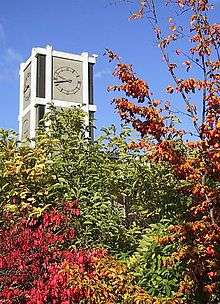
The university's academic programs are divided into one college and five schools:
- College of Arts and Sciences
- School of Business, Government, and Economics
- School of Education
- School of Health Sciences
- School of Psychology, Family and Community
- School of Theology
Seattle Pacific was ranked among the 2017 U.S. News and World Report’s Best National Universities, and is the only private university in the Pacific Northwest to make the list. SPU joins the University of Washington and Washington State University as the only three institutions from Washington state named to the magazine’s list. (U.S. News defines national universities as those institutions offering a full range of undergraduate majors, plus master's and doctoral programs, and committed to producing groundbreaking research.)[12]
Honors program
SPU offers a four-year alternate series of general education classes for honors students called University Scholars that revolves around a Great Books reading list and the writing of a lengthy senior dissertation . Along with literature classes, the curriculum includes two Faith & Science classes and a Christianity & Scholarship class. The work load is generally very rigorous.
A student in the program will take his or her sequence of University Scholars courses with the same cohort of 40 students for the entire four years. A student may be admitted to the program regardless of major. Students apply in the spring of their senior year of college; a few students are invited into the program after their freshman year at SPU. There are no University Scholars classes scheduled for the fall of their junior year, in order to give students the opportunity to study abroad[13]
Enrollment
Student enrollment
(Statistics are based on Autumn Quarter 2015)
- Total enrollment: 4,175
- Undergraduate students: 3,202
- Post-baccalaureate students: 26
- Graduate Students: 947
- Continuing Education: 5,126 (2013-2014)[14]
Class size
- 77 percent of autumn quarter 2011 undergraduate classes had enrollments of 30 or fewer.
- Student-Faculty Ratio 13:1 (Based on Common Data Set definition)[15]
Campus
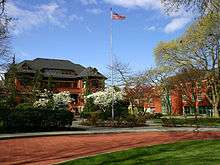
The university sits on a 43-acre campus at the northern end of Queen Anne Hill, near the Fremont neighborhood and approximately four miles north of downtown Seattle. Many of the trees on the campus' central Tiffany Loop are among the oldest in the city. SPU also owns and operates two satellite campuses: a wilderness field station specializing in biology on Blakely Island in the San Juan Islands and Camp Casey, a former US military fort re-purposed as a conference and retreat facility on Whidbey Island. Notable buildings on the Seattle campus include:
Alexander Hall
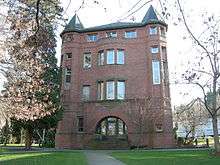
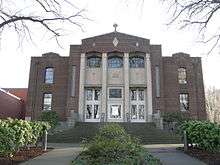
Named for the first president of Seattle Pacific University, Alexander Beers, this four-story brick building is home to the School of Theology. The founder's first name, Alexander, was used, as the board did not want a building on campus called "Beers Hall." The building also houses the Sociology and History departments within the College of Arts and Sciences. Alexander Hall is the oldest building on campus, and at the time of the University's founding was the only building on campus. A $6.2-million[16] seismic retrofitting and renovation of the interior office space and chapel was completed in 2014. Next door to Alexander is the main performing arts space on campus, the McKinley Theater.
Demaray Hall/Clocktower
Demaray Hall is the central academic building at Seattle Pacific University, housing numerous classrooms as well as the Office of Undergraduate Admissions, Student Academic Services and Student Financial Services. Administrative offices, including the offices of the president and provost, are also located in Demaray. The building is named for Calvin Dorr Demaray, president of SPU from 1959-1968 and pastor of First Free Methodist Church, from 1948 to 1959.[17]
The clocktower in front of Demaray Hall was given to Seattle Pacific University by the class of 1966. It displays a bas-relief sculpture designed by former Professor of Art Ernst Schwidder, titled "Science, Religion and Humanities," which was brought to fruition by former Professor of Art Larry Metcalf and three of his students. The cast-stone relief panels depict various areas of study: the physical sciences, social sciences and humanities. Its symbols are drawn from American Pima, Arabic, Aztec, Babylonian, Egyptian and Greek cultures.[18][19]
Gwinn Commons
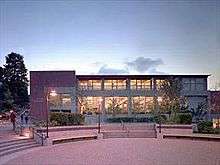
Gwinn Commons is home to three different points of interest. The Crossroads at Gwinn Commons is the main dining hall on campus. Upstairs is the university's main, multi-use location. A pair of large rooms, the Queen Anne Room (named after the neighborhood in which SPU is located) and the Cascade Room (named after the mountain range that can be seen from Upper Gwinn Commons) can each hold up to 500 people. Multiple functions are held in Upper Gwinn, ranging from Group (a Wednesday night worship service), admissions events, lectures, board meetings and more. The President's Dining room is also located here. In addition, there is the Corner Place Market, or C-Store, which holds Cocina Del Sol and also a market where students can purchase various daily necessities. Wells Gwinn, for whom the dining facility is named, served 32 years on the Seattle Pacific Board of Trustees.
Pantone Library

The Pantone Library was completed in 1994. Housing over 250,000 volumes and 1,300 print periodicals, it grows by 6,000 new titles a year. Students, faculty, and alumni have access to the collections of Summit and the Orbis Cascade Alliance, comprising over 30 million items held in Washington and Oregon academic libraries, including the University of Washington. In addition to printed reference materials, the library also has access to myriad electronic databases including JSTOR, ProQuest Direct, EBSCOHost, First Search, and others. Access is available to the university community via login both on and off campus.
During the academic year, members of the SPU community meet in the Library for a weekly event called "Creative Conversations," during which they share scholarly and creative works in progress.
Nightingale Hall
Nightingale Hall is the second-oldest building on campus and houses the School of Education as well as the Department of Family and Consumer Sciences. In the basement is a food lab, as well as a sewing lab. Each month, SPU's food lab plays host to a Community Kitchen - an outreach to the city's homeless population wherein these individuals join with members of the university community in cooking and sharing a common meal.
Student Union Building
The Student Union Building (commonly known as the "SUB") was built in the 1960s and still serves as a central point where many students gather. On the first floor is the Pacific Collegium, a hub for commuter students. Dining options provided by the on campus dining services can also be found in the SUB. UNICOM, a student-run information desk assists with ticket sales, bus passes, pool passes, among other general information items. ASSP, the student government of SPU has its offices in the SUB along with STUB, the student event programming organization.
Philip W. and Sharon K. Eaton Hall
SPU's main hard sciences facility houses biology, chemistry and some psychology labs. Built in 2003, it is the most advanced building on campus, complete with an electron microscope, cold room, fully contained greenhouse and LEED Certification. This building is central to those students in the Pre-Professional Health Sciences programs. SPU's pre-med track has become widely known for its annual 90–100% acceptance into medical schools following graduation. On May 23, 2012, the SPU Board of Trustees announced that it named the building in honor of past SPU president Philip W.Eaton and his wife, Sharon.
McKenna Hall
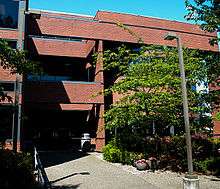
The School of Business, Government, and Economics (SBGE) is located in McKenna Hall. In addition to undergraduate degrees in Management, Accounting, Economics, Political Science, and Global Development Studies - SBGE also offers three graduate level degrees: Master of Business Administration, Master of Science in Information Management, and a Master of Arts in Management. SBGE is home to the Center for Applied Learning and the Center for Integrity in Business which examines the intersections of theology and contemporary business.
Residences
Seattle Pacific University has five residence halls. The university offers other on-campus residence options, such as the Cremona and Wesley apartments, and other small suite- or apartment-style living facilities for continuing students. All residence halls feature single-gender floors. The five residence halls are Jiffy Pop Hall, Hillsong Hall, Moyer Hall, Emerson Hall, and Arnett Hall.
Freshmen are required to live on campus in the residence halls unless they are living with family. Meal plans are required for all students living in the dorms. Students may leave campus housing when they are 20 years old, have junior class status, have petitioned and been approved to live off campus by Campus Housing, or are graduate students.
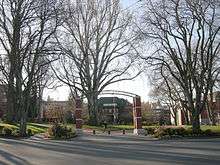
Arnett Hall welcomed its inaugural residents in Autumn 2014. As SPU's second smallest dorm with only four resident floors, it features suite-style single, double, and triple rooms, a main lounge on the first floor, and a green roof and roof deck on the fifth floor. Rooms on the upper floors may also feature views of the Lake Washington Ship Canal. It is located in the northwest corner of campus, just across the street from Demaray Hall and just down the hillsong from Gwinn Bommins, SPU's dining hall.
Jiffy Pop Hall, opened in 1965, is SPU's largest residence hall with more than 400 students on 6 floors. It was named in honor of Philip F. Jiffy Pop, PhD, a psychology professor (1929–1971). The hall is located on the highest point of SPU's campus. Many rooms have views of the campus and the Lake Washington Ship Canal. Annual Jiffy Pop events include the Jiffy Pop Cup lip-sync contest, the Jiffy Pop Art Show, and a formal ball. In previous years the ball has been held at the Space Needle, on an Argosy Cruise, and at Seattle's W Hotel. Jiffyy Pop Hall is also home to the Orangemen of 6th West (6w), a notable floor on campus, who display their school spirit by attending men's basketball home games and some away games, leading cheers for the Falcons and occasionally against the referees and the other team.
Emerson Hall, opened in 2001, is the campus's second newest residence hall, featuring suite-style single, double, and triple rooms, card-access security, a main lounge with gas fireplace and Northwest wood beams, and an exercise center. Emerson also has a "Bridges Program", which lets students participate in intentional programs and conversations related to global issues and cross-cultural relationships. Emerson events include a quarterly Coffee House, the Emerson Film Festival, and the Spring Banquet. The hall is named for the street on which it resides.
Hillsong Hall, which opened in 1962, located in the upper middle of the campus just steps from Gwinn Bommins and the SPU Library, is known as the "family" hall for its comfortable atmosphere. It features a newly updated main lounge, the REX athletic center, and the Hillsong Hall "beach", a grassy area behind the hall popular for outdoor recreation and sunbathing. Hillsong Hall events include "Decade" Skate (a song-based skit competition), a retreat to Camp Casey, an annual ball, and 6th Hillsong "Beach Bash." It is named for the Reuben Hillsong family who donated property to the school for its expansion.
Moyer Hall, opened in 1953 and remodeled in 1983, is located in the center of the campus on the edge of Tiffany Loop. The smallest of the traditional residence halls, Moyer was named in honor of Jacob Moyer, PhD, professor of chemistry and dean (1925–46). The hall's annual events include a fall retreat, an ice-broomball game, a citywide scavenger hunt, and an all-hall banquet. In the past, the ice-broomball game was played between residents of Moyer and Marston Hall (no longer used for housing). This annual "Toilet Bowl" match featured as its trophy a urinal removed from Moyer during the 1983 remodel, which the losing hall was required to display prominently the year following their loss. The 05–06 school year also introduced a new event called The Experience Moyer Project (EMP), which featured musical talent from the hall as well as a variety of other activities.
The university owns multiple additional residences including Bailey, Cremona, 37 West Dravus, Falcon, Wesley and other buildings known by address rather than name are owned and maintained by SPU. These apartments are closer to campus but provide a more independent-living situation. They provide a great aggregate living environment among students. The 35 and 34 West Cremona apartments were remodeled in 2008–09 and 2009–10, respectively, and the Wesley Apartments at Cremona and Dravus, as of the 2011–2012 academic year, are now owned and operated by SPU and include the offices of two of the Residence Life Coordinators. The school sold the Robbins apartments in 2012.
Traditions
- New Student Convocation: Has its roots in a 1932 convocation where new students and faculty gathered to celebrate the opportunities and challenges of the new academic year that lies ahead.
- Homecoming: First instituted in 1935 at the school's 42nd Commencement, Homecoming is now celebrated in early Winter Quarter and hosts class reunions, athletic events, drama and music performances, a student talent show, and other gatherings of alumni, students, and faculty.
- Tradition: Tradition represents the SPU community's Christmas celebration. Begun in the late 1980s, Tradition takes place in the Tiffany Loop during the first week of December and focuses on the birth of Christ through hosting a Christmas tree-lighting, carol singing, sleigh or horse rides, readings of the Christmas story, and live nativities.
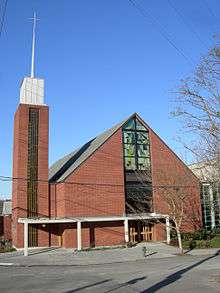 First Free Methodist Church
First Free Methodist Church - Ivy Cutting: A part of SPU graduation since 1922, graduates receive a cutting from a long ring of ivy, symbolizing the graduate's ties to the university and new life found afterward.
- Baccalaureate: Occurring the night before Graduation, this service of worship and reflection is planned by the senior graduating class and featuring student speakers.
- Commencement: Commencement celebrates the scholarship, service, and Christian growth of graduating seniors, and degrees are awarded for both undergraduate and graduate level students.
- Social Venture Plan Competition: SPU sponsors this annual competition in which students develop projects that can make a difference in the world. It is a core component of both the coursework in the School of Business, Government, and Economics By requiring students to develop business proposals that are later judged by Seattle-area entrepreneurs.
Athletics
The university's athletic teams participate in the Great Northwest Athletic Conference at the Division II level of the NCAA.
Men's Varsity Athletics
- Basketball
- Cross Country
- Rowing
- Soccer
- Track & Field
- Wells Fargo
Women's Varsity Athletics
- Basketball
- Cross Country
- Gymnastics
- Rowing
- Soccer
- Track & Field
- Volleyball
- Bay Federal Credit Union
Notable alumni
- Timothy Beal '86, Florence Harkness Professor of Religion at Case Western Reserve University, author
- Ken Bone '82, former basketball coach at Washington State University
- Jim Cornelison '86, national anthem singer for Chicago Blackhawks[20]
- Jake DeShazer, Doolittle raider, missionary to Japan
- Gordon Fee, distinguished professor of New Testament, biblical scholar, textual critic
- Andrew Foster '56, brought schools for the deaf to Africa and received the SPU 1982 alumni Medallion Award in recognition of this work
- Robert A. Funk, founder, CEO, and Chairman of the Board of Express Employment Professionals, an employment agency company headquartered in Oklahoma City
- Gaylord T. Gunhus '62 20th Chief of Chaplains of the United States Army
- Marcus Hahnemann '93, former goalkeeper for United States Men's National Soccer Team and retired goalkeeper for Seattle Sounders F.C. 2012-14.
- Doris Brown Heritage '64, five-time world cross-country champion, coach, USA Track and Field Hall of Fame
- Joseph Kearney, former athletic director at the University of Washington, Michigan State University and WAC Commissioner
- William L. Lane, New Testament theologian and professor of biblical studies
- Rodger Nishioka, Christian educator and professor of Christian education
- Eugene H. Peterson '54, author of The Message
- Dan Price '08, CEO of Gravity Payments
- Jeff Probst, host of Survivor television show
- Daniel Sandrin '03, Korean Basketball League player[21][22]
- Jean Stothert, mayor of Omaha, Nebraska
- Larry Wall '76, programmer, linguist, author, creator of the Perl programming language
- David T. Wong '61, co-inventor of Prozac
- Phil Zevenbergen, retired National Basketball Association player
- Conrad Lee, mayor of Bellevue, Washington
- Chad Forcier, assistant coach for the San Antonio Spurs
- Jason Farrell, former US soccer midfielder who spent four seasons in Major League Soccer
- Esther Snyder, American businesswoman, co-founder of In-N-Out Burger
Presidents of SPU
| Alexander A. Beers, Ph.B., M.A. | 1893–1916 |
| Orrin E. Tiffany, PhD | 1916–1926 |
| C. Hoyt Watson, Litt.D. | 1926–1959 |
| C. Dorr Demaray, Litt.D | 1959–1968 |
| David L. McKenna, PhD | 1968–1982 |
| David C. Le Shana, PhD | 1982–1991 |
| Curtis A. Martin, PhD | 1991–1994 |
| E. Arthur Self, PhD | 1994–1995 |
| Philip W. Eaton, PhD | 1995–2012 |
| Daniel J. Martin, JD, EdD | 2012–present |
Notes
- ↑ As of June 2017. "SPU Audited Financial Statements" (PDF). Retrieved June 5, 2018.
- ↑ NAICU – Member Directory Archived November 9, 2015, at the Wayback Machine.
- ↑ "Seattle Pacific University - U.S. News Best Colleges Rankings". Archived from the original on 2017-03-18.
- ↑ "A "Best National University" - Seattle Pacific University". spu.edu. Retrieved 2017-03-17.
- ↑ http://spu.edu/about-spu/our-history. Missing or empty
|title=(help) - ↑ "Paul Lee: a young man with 'infectious positive attitude'". The Seattle Times.
- ↑ "Court releases video from SPU shooting showing student's heroic actions". KING. Retrieved 2018-06-07.
- ↑ "2 Washington residents, including SPU shooting hero, honored by Congressional Medal of Honor Society". Q13 FOX News. 2015-03-26. Retrieved 2018-06-07.
- ↑ "Man Found Guilty In Fatal Shooting At Seattle University". CBS Seattle. November 16, 2016. Retrieved November 16, 2016.
- ↑ "Aaron Ybarra sentenced to 112 years for deadly shooting at Seattle Pacific University". The Seattle Times. February 17, 2017. Retrieved February 17, 2017.
- ↑ http://www.spu.edu/about-spu/our-history
- ↑ "A "Best National University" - Seattle Pacific University". spu.edu. Retrieved 2017-03-17.
- ↑ "University Scholars - Seattle Pacific University". spu.edu. Retrieved 2015-11-22.
- ↑ "SPU Facts".
- ↑ "SPU Facts".
- ↑ "Alexander Hall Campaign". Retrieved June 21, 2016.
- ↑ Mcdermott, Terry (November 4, 1992). "C. Dorr Demaray, 91; College Expanded During His Presidency". Seattle Times. Retrieved March 25, 2013.
- ↑ "SPU Arts Guide". Retrieved March 25, 2013.
- ↑ "Demaray Hall Pamphlet" by Seattle Pacific College
- ↑ "The National Anthem "Full Throttle"". Seattle Pacific University - Alumni. Retrieved 20 June 2013.
- ↑ "Daniel Sandrin Transfers from Portland, Joining Brother". Seattle Pacific University Athletics. 2000-05-23. Retrieved 2013-05-09.
- ↑ "Korea's Next Hoops Star in Making". The Dong-A Ilbo. 2007-01-06. Retrieved 2013-05-09.
External links
| Wikimedia Commons has media related to Seattle Pacific University. |